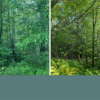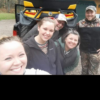Eye Safety
Welcome to March, all! Winter is still here, but thankfully, signs of spring will be arriving within a month or so.
While we still have the snow, a reminder from last month to continue to practice your snowmobile safety on the trails and in the woods and to be cautious of others. Another reminder that just because it is starting to feel warmer out does not mean you should not pack extra layers with you. March has the potential to throw some crazy weather at us, and it can change very quickly.
This month, our safety topic is less weather-based and more PPE-based. March is Workplace Eye Wellness Month, and as foresters and field staff, we all have been in a situation or two where our eyes have been in danger. There are many potential risks and hazards in the woods we are exposed to every day that could impact our eyes. Common threats to eye safety in the field include:
Branches, Buds, and Twigs
As silly as it may sound, buds and twigs can cause serious eye damage if impact occurs. Some tree buds, like beech and sugar maple, are pointed, and if one comes in contact with your eye, it could tear something, poke your eye out, or cause you to lose your vision.
Bugs
In the summer months, as we are riding our ATV’s, bugs may fly into our eyes and cause irritation or eye damage, if serious enough.
Paint/Aerosol
Every timber sale that is set up and every carbon project that is cruised will require some form of paint, whether that is tree paint sprayed on with a Nelson paint gun or aerosol spray paint numbering a tree for carbon. Paint and paint vapors could get into your eyes and cause irritation, a negative reaction, or blindness, if severe enough.
Tools/Equipment
When in the woods we sometimes use tools such as hammers, handsaws, nails, potentially chainsaws, and more. Using these tools can pose a threat to our eyes as they can create sawdust that may get into our eyes or throw other debris.
The easiest way to prevent eye damage in these scenarios is to wear safety glasses or goggles. Steigerwaldt provides safety glasses to each field staff member.
Safety glasses will shield your eyes against most debris and paint splatter and help keep you away from the hospital and suffering permanent eye damage. If something does get into your eye, like paint or chemicals, Steigerwaldt has eyewash kits located in every work truck to thoroughly wash the contaminates out of our eyes. If an eye injury is serious, a coworker will drive the team member to the nearest hospital to have it checked and treated.
Office
In an office setting, excessive computer, tablet, and smart phone use throughout the day increases the risk of digital eye strain, dry eyes, blurred vision, and headaches. Take frequent breaks by using the “20-20-20” rule, as recommended by the American Academy of Ophthalmology and the and the American Optometric Association. Every 20 minutes look away from your screen and look at an object 20 feet away for at least 20 seconds. This gives your eyes a chance to reset and replenish themselves.
“Healthy vision is crucial for productive work, independence, and quality of life,” said Jeff Todd, president and CEO of Prevent Blindness. “We must make our eyes a priority today to help maintain healthy eyesight throughout our lives.”
As always, stay safe out there, and enjoy these last few weeks of winter!
-Nate Loeffler, Forester







